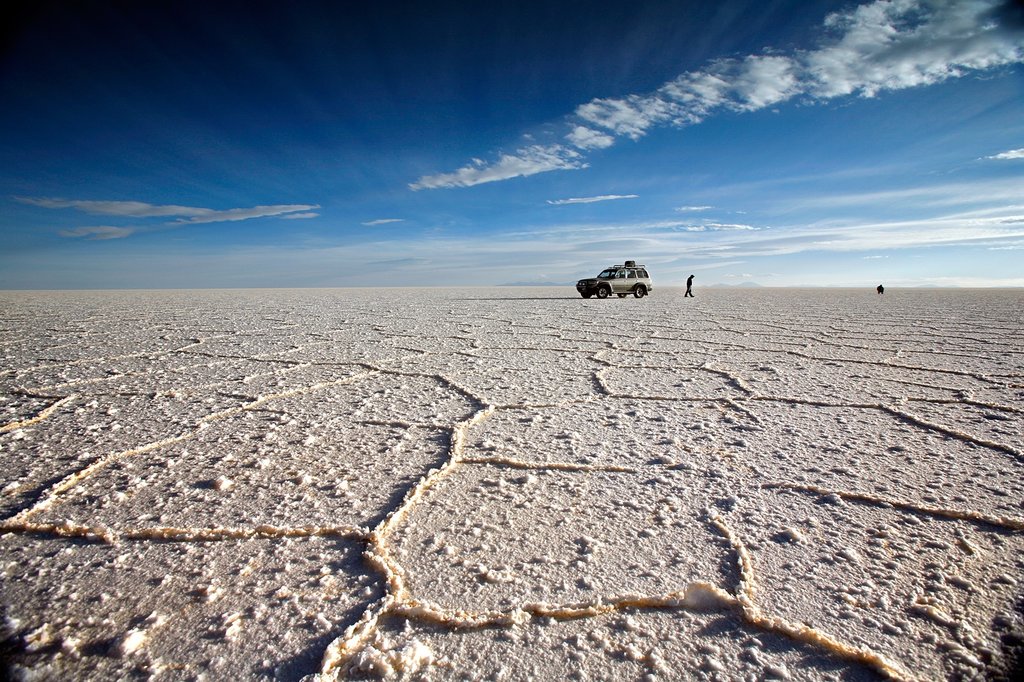Brief itinerary
| Day | Highlights | Overnight |
|---|---|---|
| Day 1 | Trek between Tupiza Canyons | Tupiza |
| Day 2 | Beautiful drive from Tupiza to Guadalupe | Guadalupe |
| Day 3 | Short hike around Ciudad de Roma | San Pablo de Lipez |
| Day 4 | Visit the ancient village of San Antonio del Nuevo Mundo | Quetena |
| Day 5 | Trip to Laguna Colorada & Siloli Desert | Siloli Desert |
| Day 6 | Drive through the scenic "route of the Jewels" | San Juan |
| Day 7 | Salar de Uyuni & the "Cave of the Galaxy" | Colchani |
Detailed itinerary
Day 1: Tupiza

Today you'll enjoy a unique trek between Tupiza Canyons. One of the easiest and shortest walks - 4 hours, 9 km round trip, 200m drop. You'll depart at 9 am from the hotel for a fantastic red, deep and narrow canyon where a small river flows during the rainy season. Explore various rock formations, canyons and other geological curiosities from the west part of Tupiza: Puerta del Diablo, Valle de Los Machos (rock formations), el cañón del Inca, La Quebrada Seca, and Cañón del Duende.
At the exit of the canyon, you'll discover a beautiful valley of giant cacti where you can find historic ruins of old houses occupied by the old Chichas of the pre-Inca indigenous culture. We'll then head back to Tupiza in the afternoon.
Day 2: Tupiza to Guadalupe

From Tupiza, we ascend the beautiful canyon until Palala Sillar, where the diversity of landscapes (canyons, craters) make it a lunar spot with colors both warm and intense, pastel and pale.
We'll then continue our way up to desolated mining areas of Nazarenito, Chilcobija, Trapiche and San Pablo de Lipez (capital of the South Lipez ), before arriving in the late afternoon in Guadalupe where we spend the night.
Day 3: Guadalupe to San Pablo de Lipez

In the morning, we leave the village of Guadalupe for a short hike around the Guadalupe formations (also known as "Ciudad de Roma"). The peak is bristling with numerous rocky penitents that remind us of the Algerian Tassili.
From the top, we discover an extraordinary landscape of eroded monumental rock formations whose tones vary from white to red passing through all shades of ocher and gray. Accompanied by your guide specialist of the area, you will see incredible rock formations appearing to take various shapes: cathedrals, crocodiles, condors, and llamas. The landscape is surrounded by several snow-capped volcanoes, including the wide range of Cerro Lípez (5930 m). We'll explore the site before going back to Guadalupe and continuing by road to San Pablo de Lipez.
Day 4: San Pablo de Lipez to Quetena

Today, we'll visit the ancient village of San Antonio del Nuevo Mundo. According to legend, the village was suddenly abandoned due to a massive and unexplained invasion of viscachas (a typical rodent of the area). Then, we'll pass by the strange geological formation of the “Torreón” and cross over a 4500m pass before descending to Laguna Morejón. A detour will take us to the remote Laguna Celeste. Then, we'll get back on the road and head towards the village of Quetena.
Day 5: Quetena to Siloli Desert

Today, we continue enjoying the landscapes of the Sur Lipez area. We will start the day with the Laguna Colorada (4278 m), located 50 km. to the west from Quetena. This immense lake of pinkish water owes its name to the presence of light sensitive phytoplankton in its water, which also attracts thousands of flamingos during certain times of the year.
Then, we'll head north for 70 km. to the Siloli Desert (4700 m) where we will spend the night. Before arriving, we'll pass by the famous Stone Tree. Keep your eyes open: it is not unusual to spot some viscachas (Andean rabbits) in this area.
Day 6: Siloli Desert to San Juan

Today, we'll drive north along the Chilean border on the scenic “route of the Jewels”, due to all the lagoons along the way: Lagunas Honda, Ch’arkota, Hedionda, and Cañapa, a sanctuary to three varieties of flamingoes. Stop at the mirador of the volcano Ollague.
Still active today, this volcano contains one of the world’s highest open pit copper mines. The track descends from 4200 m to 3600 m. We'll cross the small Salar de Chiguana at the base of the volcano Tomasamil (5900 m) before reaching San Juan at the end of the day.
Day 7: San Juan to Uyuni to Colchani

A two-hour trip from San Juan will take us to the Salar de Uyuni (3650 m). The atmosphere is amazing: the horizon appears endless and the feeling is overwhelming. We'll then head north to the island of Incahuasi. This island of volcanic origin is covered with stromatolites (fossilized bacteria representing the first traces of life on earth) and giant cacti.
On the way, we'll visit the “Cave of the Galaxy” and its stalactites resembling lace. In the afternoon, head east towards Uyuni. On the way, we'll stop by the Salt Hotels (closed since November 2001) and the salt exploitation of Colchani.


